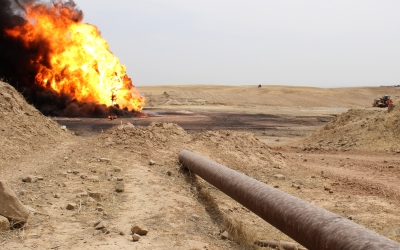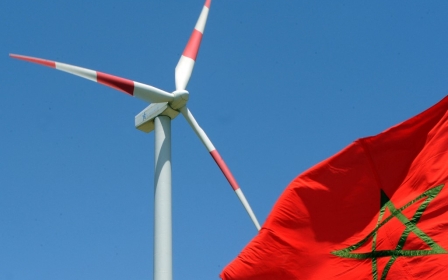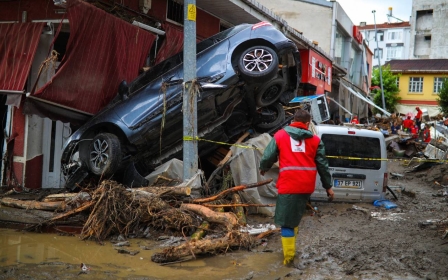COP26: Syria is a warning of climate disaster that region cannot ignore

The COP 26 summit in Glasgow that ended last month has seen world leaders attempt (quite unsuccessfully, again) to discuss and agree on measures to combat the climate threat and ensure our children’s future.
This dire situation reminds us of the time, not so long ago, when the Syrian government was being urged by international aid organisations to address a mounting ecological crisis. The government’s lack of response fuelled extreme poverty, which ultimately triggered the domestic social unrest that led to the Syrian war.
We personally witnessed instances of heavy over-exploitation of the steppe, both through over-grazing of livestock and the intensification of agriculture
Rural areas were most affected by the ecological crisis, which might explain why the rebellion grew stronger initially in these derelict and forgotten parts of the country. Based on our long-term experience working with both international organisations and the government in Syria, we know what is at stake if world leaders fail to act on the global climate crisis.
Between 2000 and 2010, we worked with government and non-government agencies and institutions on issues related to the conservation of biodiversity and local development. In the historic city of Palmyra, in the centre of Syria’s semi-arid steppe (“al-Badia” in Arabic), we witnessed the final stages of an ecological crisis that had been looming for at least three decades.
Throughout history, al-Badia had supported the livelihoods of nomadic and indigenous Bedouin herders, along with the sedentary agricultural population. Across millennia, al-Badia proved to be resilient to droughts, enabling the development of several extraordinary ancient civilisations.
New MEE newsletter: Jerusalem Dispatch
Sign up to get the latest insights and analysis on Israel-Palestine, alongside Turkey Unpacked and other MEE newsletters
Yet, during the 2000s, we reached a tipping point. We personally witnessed instances of heavy over-exploitation of the steppe, both through over-grazing of livestock and the intensification of agriculture. The Syrian government viewed the maximisation of agricultural yields to be of the utmost importance, despite warnings that the fragile ecosystem would not be able to cope in the long term.
Reduced crop yields
During the 2000s, the country began suffering prolonged droughts, exacerbated by advancing climate change, ultimately forcing the Syrian government to resort to requesting urgent international food aid for the first time in its history.
We personally witnessed massive queues of people waiting for basic food items, and spoke with herders of sheep and camels who had lost significant portions of their herds because they could not supply sufficient food and drink. Sandstorms increased in frequency, with massive negative impacts on the agricultural sector and reduced crop yields.
As such, the environmental crisis gradually and inexorably started affecting the quality of life of a critical mass of rural Syrian people. In his book Revolt in Syria: Eyewitness to the Uprising, journalist Stephen Starr described a visit to Palmyra in 2009, during which he noticed that children in al-Badia were visibly malnourished, sitting in rags on street pavements, while young men with no jobs or entertainment would drive motorbikes aimlessly around town for hours.
In Palmyra, which joined the 2011 protest movement shortly after the initial uprising in Daraa, young university students and impoverished farmers demonstrated alongside destitute Bedouin herders. But rather than trying to calm protesters or meet some of their demands through reforms in the development sector, the Syrian government led a harsh crackdown.
What we witnessed in Palmyra was a microcosm of similar dynamics unfolding across Syria’s rural areas. The ecosystem of al-Badia, which had been sustainable for millennia, had been over-used in just a few decades and reached a tipping point. Its resilience withered in the face of the massive tide of climate change.
Warnings ignored
The recommendations and warnings of science were ignored by the Syrian government for decades. Piles of documents developed during workshops and conferences ended up in drawers, covered in dust.
Is the Syrian story not applicable and extendable on a larger scale?
During our work in the country, we experienced the government’s determination to deny any responsibility for the disaster, alongside a complete lack of awareness in forecasting the consequences. Officials would typically justify losses as being simply due to extreme droughts and climate change, even when we provided evidence to the contrary.
Today, on a global scale, we are confronted by a deepening ecological and climate crisis affecting the entire planet - and blatant inaction from most world governments, who, much like the Syrian government, appear to be in a state of denial.
Is the Syrian story not applicable and extendable on a larger scale? How much longer will we have to wait before the current global crisis morphs into dangerous regional wars over dwindling resources?
The views expressed in this article belong to the author and do not necessarily reflect the editorial policy of Middle East Eye.
Middle East Eye delivers independent and unrivalled coverage and analysis of the Middle East, North Africa and beyond. To learn more about republishing this content and the associated fees, please fill out this form. More about MEE can be found here.





